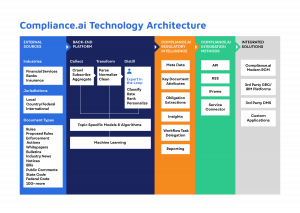Welcome to the Compliance.ai Developer Platform.
This training section provides an overview of the Compliance.ai Developer Platform and your integration options. Through our integration methods, users and partners using third party GRC or IRM solutions have access to Compliance.ai’s regulatory content that is collected from various industries, jurisdictions, and agencies.
We assess the content, transform and extract the key data, and provide key classifications like obligation assessment and enforcement actions using machine learning with the help of our Experts in the Loop.
This enriched content is made available in the pro.compliance.ai application in addition to the developer platform.
Let’s go through each method you can use to access and utilize Compliance.ai data
Three Integration Options:
We have three integration methods – API, RSS, and Service Connector. This diagram helps us visualize how the content moves from compliance.ai to your system, through each of the methods.

The far right section displays the methods customers and partners can use to pull content into their system, either through the API or RSS service. In both these scenarios, the customer or partner’s system periodically looks for new content and retrieves it while maintaining all filters and attribute mapping themselves.
The far panel displays the Service Connector method that publishes content into the customer’s destination of choice – sftp, webdav, s3, or azure folder or by directly invoking the customer’s api endpoint.
Content is published based on the user criteria set in the alerts and workflow on the compliance.ai application, see top left.
Here are more details regarding each integration method.
Comparison –
- In addition to providing amazing regulatory content, each integration method gives access to all attributes available for a document along with the ability to configure them when mapping.
- Each integration is secured with TLS 1.2 and above, and can have multiple instances that are uniquely configured for different purposes. For example, some clients use a combination of different integration methods like RSS in addition to the Service Connector, and also different instances of the same integration method by having different configurations for multiple Service Connectors.
- Of the different data format’s, Compliance.ai can provide content in, the Service Connector option has the flexibility to publish in all of our available formats – JSON, CSV, & XML. While the developer API is in JSON and RSS is in XML
- Another key difference in the integration methods is how the content moves from compliance.ai into the customer’s system.
- If the RSS or Developer API service is used, then the customer themselves are periodically looking for and retrieving new content. Where as the Service Connector is actually publishing new content into your destination of choice.
Comparison –
- Within the three integration options from Compliance.ai, each one has certain key distinctions over the others.
- Using the RSS service is our quickest and fastest integration method. You can get up and running within hours, all you have to do is log into your Team Edition of pro.compliance.ai, create an alert with your required criteria, and then an RSS url is generated for each alert. The RSS url can be used in any RSS reader, or plugged into a third party GRC system. Additionally, we can also configure and map the document attributes that are passed through RSS
- Now with the Developer API, you are able to access multiple endpoints that provide a list of values like agencies, topics, document types, jurisdictions, etc that are used in the compliance.ai platform. This is helpful when there is a need to maintain these lists and the changes to them on the client or partner system.
- Additionally, since the response results from the Search Document endpoint of our API includes all document attributes, we are able to build content libraries that have tree structures like CFRs, PubLaw, US Code – similar to what is found in the Resource section of our application.
- When using the Service Connector – in addition to the flexibility provided by what data format and location to publish in, we are able to utilize the workflows created on the application to create task dependencies. This means that when documents fall under a certain alert’s search criteria, the user can create a task to have those documents reviewed and/or labeled by a team member before the content is pushed into their GRC system. This provides an extra level of analysis on the content before it is published
- This extra level of analysis can include labels, user generated annotations and obligations. In our application, a user has the ability to add their own annotations and obligations to certain documents to further narrow down the requirements they need to comply with.
- When paired with the tasks dependencies from workflow, you have the flexibility of publishing all obligations and annotations found on a document or publishing only the ones that a team member has reviewed and/or added. Another use case we have seen is that documents that meet an alerts criteria are all pushed into the GRC system, and then when a team member adds in their annotations to the document within our application after the fact, those added annotations are then published into the GRC system and a relation to the document that was previously published is created within that system
The Compliance.ai Developer Platform allows a lot of flexibility for integration with your existing systems.



